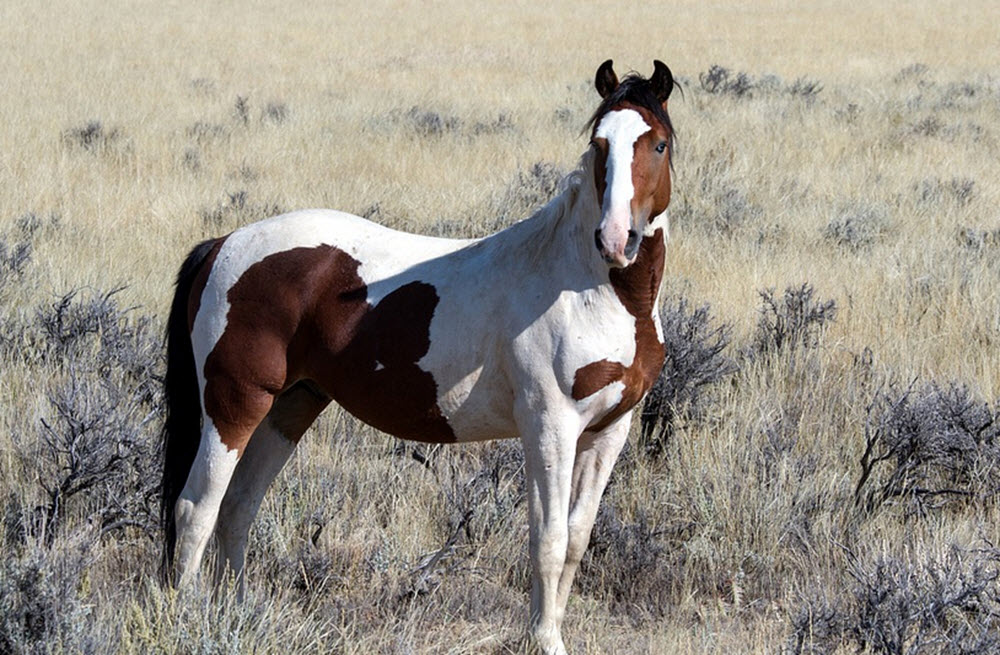On this page:
The mustangs chiefly descend from horses brought to North America by the Spanish during the colonial era, but other horses have also contributed to the breed. More isolated population tend to have a stronger resemblance to the original Spanish stock than mustang populations living in less isolated areas.

Today’s mustangs are associated with the Western United States, where a majority of the mustangs are free-roaming and have no owner. They are sometimes referred to as wild horses, but their ancestors where domesticated horses so a more correct term would be ferral horses.
Characterstics
As mentioned above, mustangs chiefly hail from Colonial Spanish horses, but other horse breeds have also contributed to the modern mustang. Also, living their life out in the wild for so many generations has favored certain traits through natural selection, and mustangs are generally hardy and surefooted horses with excellent endurance.
Coat
Mustangs come in a wide variety of coat colors and patterns.
In two of the Herd Mangement Areas in Nevada supervised by the U.S. Bureau of Land Management (BLM), you can encounter mustangs with curly coats.
Body type
Statistics from the BLM’s Herd Management Areas show that in these areas, the light ridiing horse body type dominates, but there are also mustangs there that display draft horse characteristics.
Some specific mustang herds show signs of having some genetic material from Thoroughbreds or other light horserace-type horses. There are for instance herds in Idaho where some of the male ancestors are known Thoroughbred and Quarter Horse individuals that were abandonned by their owners and joined a mustang herd.
How many free-roaming mustangs are there in the United States?
In August 2017, the BLM estimated that there were over 72,000 on-range mustangs in the United States.
(Another 45,000 mustangs were in holding facilities, i.e. not free-roaming anymore.)
Where do the free-roaming mustangs live?
More than 50% of all the free roaming mustangs in the United States live in Nevada. Other examples of states with substantial populations are California, Oregon, Utah, Montana, and Wyoming.
The American Mustang Association
The American Mustang Association is no longer active, but used to keep a breed standard for mustangs.
Examples of desirable traits included in this breed standard:
- Well-proportioned body
- Clean head with wide forehead and small muzzle
- Straight or slightly convex facial profile
- Long and sloping shoulders
- Withers of moderate height
- Short back
- Deep girth
- Rounded croup
- Low-set tail
- Straight and sound legs
- Round and dense hooves

Management
Since the free-roaming mustangs have no owner, they are managed by the U.S. Bureau of Land Management (BLM).
In 1971, the U.S. Congress declared that “wild free-roaming horses and burros are living symbols of the historic and pioneer spirit of the West, which continue to contribute to the diversity of life forms within the Nation and enrich the lives of the American people.”
In recent years, the BLM’s culling and foreful removal of mustangs from range lands to keep populations down have meat with great controversy.
It is possible for private individuals to adopt mustangs from the BLM, but the number of willing adopters is not large enough to satisfy the need for new homes. Because of that, many mustangs are currently being held in temporary or long-term holding areas.
The BLM has designated Herd Management Areas (HMA) for the free-roaming mustangs and established “Appropriate Management Levels” for each of these areas. In total, the BLM sees 26,000 free-roaming mustangs as appropriate, divided over the various HMA:s.
